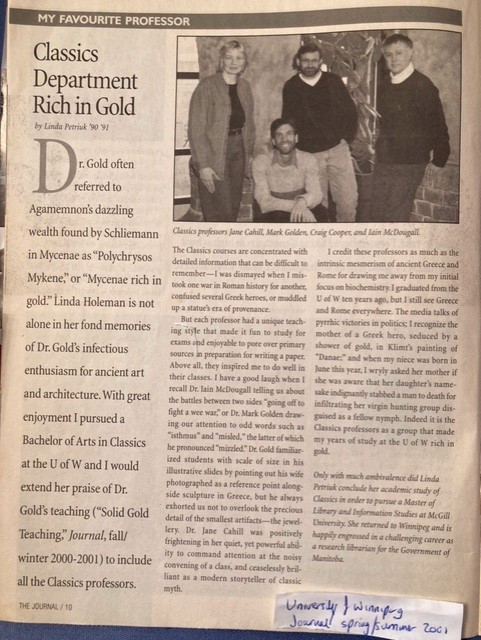Departmental History
Thank you to Dr. Jane Cahill, retired Classics professor and Senior Scholar, for sharing these items from the early days of the Classics department at the University of Winnipeg.
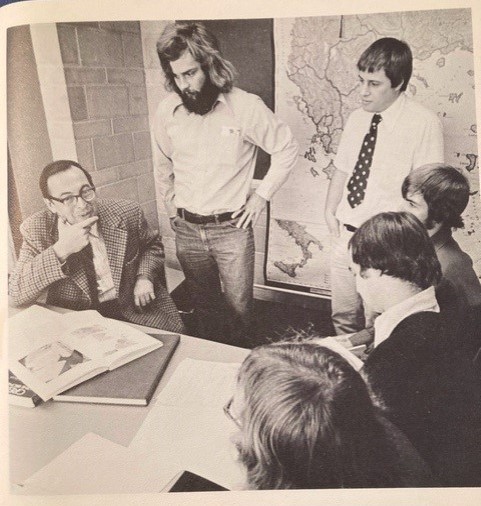
From a booklet called “Information for Prospective Students ’76/’77”.
Bob Gold seated on the left; Mike Bellhouse, a student of the department and the son of the then-Registrar, centre; and Iain McDougall standing on the right.
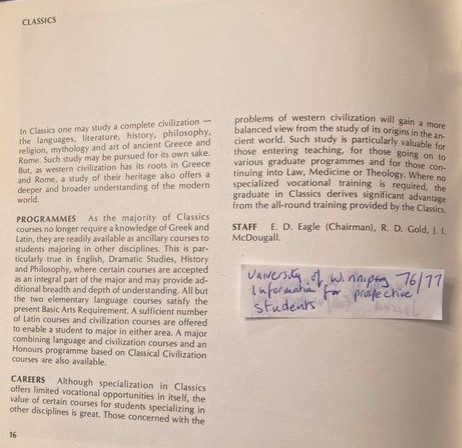
Page 16 of “Information for Prospective Students ’76/’77”
In Classics one may study a complete civilization – the languages, literature, history, philosophy, religion, mythology and art of ancient Greece and Rome. Such study may be pursued for its own sake. But, as western civilization has its roots in Greece and Rome, a study of their heritage also offers a deeper and broader understanding of the modern world.
PROGRAMMES
As the majority of Classics courses no longer require a knowledge of Greek and Latin, they are readily available as ancillary courses to students majoring in other disciplines. This is particularly true in English, Dramatic Studies, History and Philosophy, where certain courses are accepted as an integral part of the major and may provide additional breadth and depth of understanding. All but the two elementary language courses satisfy the present Basic Arts Requirement. A sufficient number of Latin courses and civilization courses are offered to enable a student to major in either area. A major combining language and civilization courses and an Honours programme based on Classical Civilization courses are also available.
CAREERS
Although specialization in Classics offers limited vocational opportunities in itself, the value of certain courses for students specializing in other disciplines is great. Those concerned with problems of western civilization will gain a more balanced view from the study of its origins in the ancient world. Such study is particularly valuable for those entering teaching, for those going on to various graduate programmes and for those continuing into Law, Medicine or Theology. Where no specialized vocational training is required, the graduate in Classics derives significant advantage from the all-round training provided by the Classics.
STAFF
E. D. Eagle (Chairman), R. D. Gold, J. I. McDougall.
A note from Dr. Jane Cahill (Senior Scholar) on the staff listing:
Ed Eagle retired in the summer of ’76, Iain McDougall became "Chairman" and [Jane Cahill] joined the department in the fall of ’76.
A highlight of this year’s OPEN HOUSE will be the reenactment of a Roman wedding staged by first year students in the Classics department.
The 15-minute performance will be repeated several times during the afternoon and visitors will be able to sample delicacies from the wedding feast.
The ceremony will be typical of the early empire, says Jane Cahill, a member of the department. Most marriages during the period were arranged by parents for political reasons, she says. “But occasionally people married for love.” Many marriage customs of the period have survived to our own time and Dr. Cahill thinks that OPEN HOUSE visitors will be interested to learn their significance.
The first of the wedding day rituals took place at the bride’s father’s home. A pig was sacrificed and the Auspex, a seer, examined the entrails. If they were flawless, the marriage was allowed to proceed. The parts of the sacrificial animal not burned for the gods were eaten as part of the wedding feast.
For a brief period on the wedding day, as they travelled from one house to another, the bride was under the protection of neither her father’s nor her husband’s household gods. Her costume was designed to protect her from the evil spirits which the Romans were convinced would try to attack her at this vulnerable time. Her tunic, white for a happy festive day, covered her from neck to toe. It was fastened by a girdle tied with a double knot to foil the gods. Her veil and sandals were flame-coloured for luck.
Since the gods don’t like iron, her hair had been parted with an iron spear and plated into three braids on either side. This was an archaic style but considered lucky.
As the bride journeyed to her new home guests in the procession sang songs and told lewd jokes which were considered good magic. The bride was attended by three little boys who had both parents living, a sign that the gods looked favourably on them. One walked in front, the others at either side holding her hand. One of the boys carried a torch of hawthorn twigs which he later tossed to the guests. The person who caught it was assured of a long and happy life. A woman carrying spinning equipment walked immediately behind the bride in an attempt to trick the gods into believing that this [was just an ordinary day].
The bride was carried over the threshold of her new home by her husband. The doorway was full of gods, says Dr. Cahill, and they were not yet used to this new member of the household. “If one of them tripped her up it would be a terrible omen.” To [please] these gods the bridge would smear the door with wolf fat, a magic substance and drape it with wool. The Romans believed that wool, like hair and fingernails, was [neither dead or alive] and had a special magic.
Once in the house the bride’s husband invited her to touch fire and water, purifying substances which would cleanse away her any remaining loyalties to her father’s household gods. The act was also a symbol that he would share all he had with her.
The students will stage the wedding with a budget of about $50. “The have to [play] around a bit,” says Dr. Cahill. She notes that many of the costumes, and from the scene from Roman life staged at last year’s Open House, were borrowed […].
Dr. Cahill says that members of the Classics department welcome OPEN HOUSE as an opportunity to explain their discipline. “It’s often seen as part of the English department. People assume we deal with this like Dickens.” It also provides the opportunity to quash a rumour which she says frequently goes the rounds. Students wishing to study in the department are not required to speak Latin or Greek.
Image captions: a) Jane Cahill; b) Students in Classics staged a scene from Roman life at last year’s Open House
From "Inside info," Vol.9, February 1980.
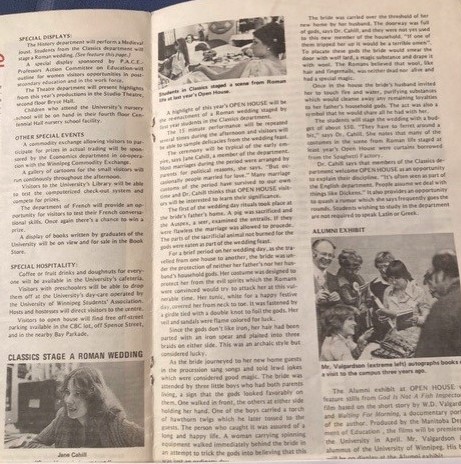
Remembering Favourite Professors
Solid Gold Teaching
by Linda Holeman ’72
I can’t remember why I registered for Dr. Gold’s Intro Art and Archaeology class back in 1969, my first year at the University of Winnipeg. It could be that it fit into my schedule—I needed to take my classes in the morning so I could work in the afternoon. It’s not as if I were absolutely dying to find out about Greek and Roman art and archaeology, but all it took was two classes to hook me. I fell in love with Dr. Gold’s enthusiasm, with his obvious love for those friezes and frescoes and storage vessels and red columns that were all—if you can forgive the pun—Greek to me. Something about Dr. Gold’s passion nudged awake my own unknown, humbling passion about a part of life—the amazing wonders of the ancient world—that I’d never really thought about before.
I was unable to get Dr. Gold’s voice out of my head, even after the class was over and I’d moved into second year. I also knew that one day I’d need to see for myself what he was talking about with such fervor, such obvious, unabashed love. And so a few years later, there I was, on Crete, standing amidst the ruins of the great palace of Knossos. It was a warm November day—off season for tourists—and I had the place almost to myself. And as I roamed about, quietly, finding the parts of the palace Dr. Gold had escribed to us using slides from his own travels there, my eyes tracing the fresco relief of the priest king, viewing the dolphin frieze in the queen’s apartment, taking in the majesty of the carves horns of Minotaur, I could hear Dr. Gold. Suddenly those words—so out of place in Winnipeg—words like portico and anteroom, labyrinth and pithoi—had meaning, and were real. And I realized something integral about Dr. Gold and what he brought to his students, and what had happened all those cold, blustery Winnipeg mornings as I sat in that sterile classroom in Lockhart Hall. I could see now that Dr. Gold possessed tiny pieces of the places and objects he loved and loved to talk about. The sun-baked warmth, the scent of the Mediterranean, the distant clanging of goat bells—they were in his voice, and in his expression, and in the way he moved his hands when he described the art and artifacts. All these senses were soaked into his being—and perhaps his toga, which he wore to class one memorable day—and Dr. Gold transmitted this to me, this subliminal gift, from his pores to mine.
Because of Dr. Gold I fell in love with the idea of travel to distant places, to see and hear and touch and smell antiquity for myself, to try and understand how the present world is related to the past. Dr. Gold won’t remember me. I was shy, and sat at the back of the class, and never asked questions or visited him in his office, and my marks were simply adequate. But I owe much of my curiosity about the world to him, and will be forever grateful.
Linda Holeman ’72 is the author of seven adult and young adult fiction novels. Recently, she was the writer-in-residence at the Winnipeg Centennial Library.
Page 20 of the University of Winnipeg Journal, Fall/Winter, 2000/01
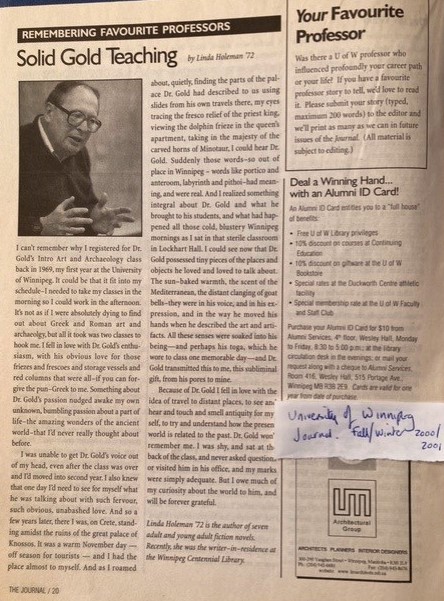
My Favourite Professor
Classics Department Rich in Gold
By Linda Petriuk ’90 ’91
Dr. Gold often referred to Agamemnon’s dazzling wealth found by Schliemann in Mycenae as “Polychrysos Mykene,” or “Mycenae rich in gold.” Linda Holeman is not along in her fond memories of Dr. Gold’s infectious enthusiasm for ancient art and architecture. With great enjoyment I pursued a Bachelor of Arts in Classics at the U of W and I would extend her praise of Dr. Gold’s teaching (“Solid Gold Teaching,” Journal, fall/winter 2000-01) to include all the Classics professors.
The Classics courses are concentrated with detailed information that can be difficult to remember—I was dismayed when I mistook one war in Roman history for another, confused several Greek heroes, or muddled up a statue’s era of provenance.
But each professor had a unique teaching style that made it fun to study for exams and enjoyable to port over primary sources in preparation for writing a paper. Above all, they inspired me to do well in their classes. I have a good laugh when I recall Dr. Iain McDougall telling us about the battels between two sides “going off to fight a wee war,” or Dr. Mark Golden drawing our attention to odd words such as “isthmus” and “misled,” the latter of which he pronounced “mizzled.” Dr. Gold familiarized students with scale of size in his illustrative slides by pointing out his wife photographed as a reference point alongside a sculpture in Greece, but he always exhorted us not to overlook the precious detail of the smallest artifacts—the jewellery. Dr. Jane Cahill was positively frightening in her quiet, yet powerful ability to command attention at the noisy convening of a class, and ceaselessly brilliant as a modern storyteller of classic myth.
I credit these professors as much as the intrinsic mesmerism of ancient Greece and Rome for drawing me away from my initial focus on biochemistry. I graduated from the U of W ten years ago, but I still see Greece and Rome everywhere. The media talks of pyrrhic victories in politics; I recognize the mother of a Greek hero, seduced by a shower of gold, in Klimt’s painting of “Danae;” and when my niece was born in June this year, I wryly asked her mother if she was aware that her daughter’s namesake indignantly stabbed a man to death for infiltrating her virgin hunting group disguised as a fellow nymph. Indeed it is the Classics professors as a group that made my years of study at the U of W rich in gold.
Only with much ambivalence did Linda Petriuk conclude her academic study of Classics in order to pursue a Master of Library and Information Studies at McGill University. She returned to Winnipeg and is happily engrossed in a challenging career as a research librarian for the Government of Manitoba.
Image caption: Classics professors Jane Cahill, Mark Golden, Craig Cooper, and Iain McDougall.
Page 10 of the University of Winnipeg Journal, Spring/Summer 2001
